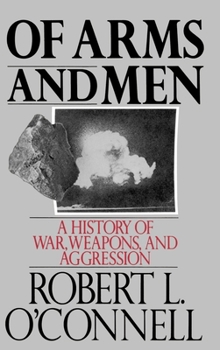Of Arms and Men: A History of War, Weapons, and Aggression
Select Format
Select Condition 
Book Overview
The appearance of the crossbow on the European battle field in A.D. 1100 as the weapon of choice for shooting down knights threatened the status quo of medieval chivalric fighting techniques. By 1139 the Church had intervened, outlawing the use of the crossbow among Christians. With this edict, arms control was born.
As Robert L. O'Connell reveals in this vividly written history of weapons in Western culture, that first attempt at an arms control measure characterizes the complex and often paradoxical relationship between men and arms throughout the centuries. In a sweeping narrative that ranges from prehistoric times to the nuclear age, O'Connell demonstrates how social and economic conditions determine the types of weapons and the tactics used in warfare and how, in turn, innovations in weapons technology often undercut social values. He describes, for instance, how the invention of the gun required a redefinition of courage from aggressive ferocity to calmness under fire; and how the machine gun in World War I so overthrew traditional notions of combat that Lord Kitchener exclaimed, "This isn't war " The technology unleashed during the Great War radically altered our perceptions of ourselves, as these new weapons made human qualities almost irrelevant in combat. With the invention of the atomic bomb, humanity itself became subservient to the weapons it had produced.
Of Arms and Men brilliantly integrates the evolution of politics, weapons, strategy, and tactics into a coherent narrative, one spiced with striking portraits of men in combat and penetrating insights into why men go to war.
As Robert L. O'Connell reveals in this vividly written history of weapons in Western culture, that first attempt at an arms control measure characterizes the complex and often paradoxical relationship between men and arms throughout the centuries. In a sweeping narrative that ranges from prehistoric times to the nuclear age, O'Connell demonstrates how social and economic conditions determine the types of weapons and the tactics used in warfare and how, in turn, innovations in weapons technology often undercut social values. He describes, for instance, how the invention of the gun required a redefinition of courage from aggressive ferocity to calmness under fire; and how the machine gun in World War I so overthrew traditional notions of combat that Lord Kitchener exclaimed, "This isn't war " The technology unleashed during the Great War radically altered our perceptions of ourselves, as these new weapons made human qualities almost irrelevant in combat. With the invention of the atomic bomb, humanity itself became subservient to the weapons it had produced.
Of Arms and Men brilliantly integrates the evolution of politics, weapons, strategy, and tactics into a coherent narrative, one spiced with striking portraits of men in combat and penetrating insights into why men go to war.
Format:Hardcover
Language:English
ISBN:0195053591
ISBN13:9780195053593
Release Date:March 1989
Publisher:Oxford University Press
Length:384 Pages
Weight:1.65 lbs.
Dimensions:1.3" x 6.4" x 9.5"
Customer Reviews
2 ratings
Interesting - picks up and keeps going after page 61
Published by Thriftbooks.com User , 18 years ago
The first 20 or so pages did not rivet me, so the book sat on the shelf for years. However this Memorial Day I picked it up again, and the depth-of-analysis beginning on page 61 I found very cool. A bow is not a bow ! Of course I've never fired anything but a fiberglass techno-marvel - what was the draw-weight of an English Longbow, why did it have to be long, what was the effective range ? The author has a nice feel for details-that-matter, and there is no "padded" feel - at least after page 61, the author shows good taste in concisely providing not-commonly-known insights, sticking those footnotes-I'll-never follow-up-on after page 310 so they don't clutter the main text. The world has changed since 1990, but you knew that - these principles-from-ancient-times, maybe you DIDN'T !
Fascinating and quite enlightening, though somewhat out-of-date
Published by Thriftbooks.com User , 19 years ago
This book was published in 1989, during the final phases of the Cold War. In it, author Robert L. O'Connell looks at the history of Western man's relationship to weapons. As the author goes through the military history of the West, from ancient Sumer to the invention of the nuclear weapon, he shows that warfare has swung like a pendulum between two poles. At one end is the Homeric view of war, wherein it is cloaked in rules and traditions which moderate and "humanize" it. At the other end is the interspecific hunt view of war, wherein rules are jettisoned and brutality reaches extremes. In the author's view, beginning with the American Civil War and becoming obvious with World War I, the advance of military technology has made weaponry so lethal that the idea of a moderate war has become an oxymoron. Also, with the advent of nuclear weapons, war has entered a final stage where it only can be a ruthless genocide of noncombatants. "We live on the edge of destruction." But, reading this book some sixteen years after its initial publication, I can't help but find that the author's terminal diagnosis for war was premature. Nuclear weapons have receded into the background as weapons of war, while new forms of warfare have arisen in the form of transnational terrorism employing weapons designed to cause mass casualties. Plus, at least for national players on the world stage, moderation, in the form of rules of engagement, weapons use and prisoner treatment is now demanded by worldwide public opinion. So, am I saying that this is a worthless, out-of-date book? In fact, I am not! Up until the final chapter, this is a fascinating and quite enlightening book. Plus, I must say that I found it to be quite a stimulating read. So, if you want to read a book that is a fascinatingly different look at military history, then this book is for you. I highly recommend it!






